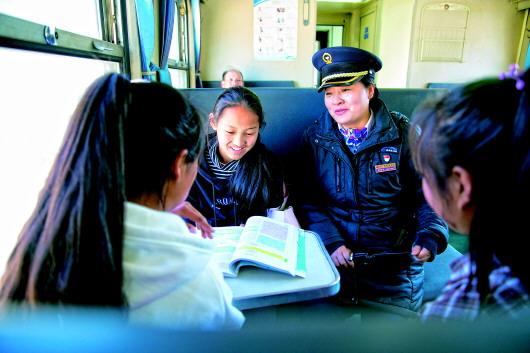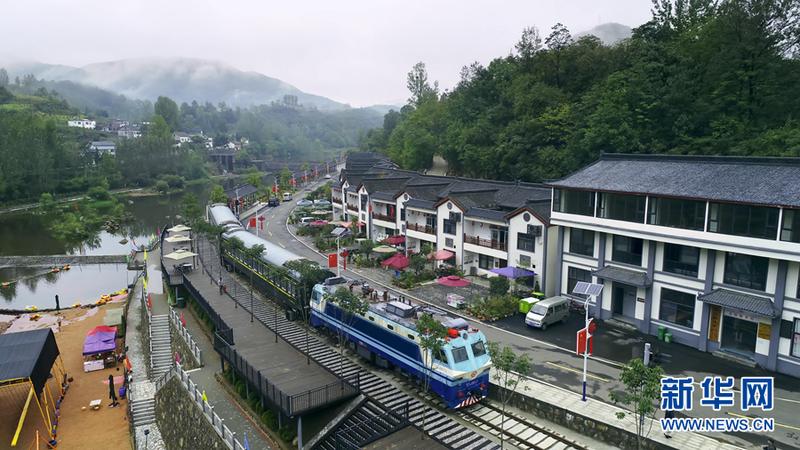


By Zhang Jiaqi
In 1996, 21-year-old Axi Aga began her career on the No. 5633 train of Chengdu-Kunming Railway as a train attendant. The train runs 353 kilometers in southwest China through the country's largest communities of Yi ethnic group, connecting 26 stations and the nearby villages.

The carriages painted in green had the typical look of China's trains at the time. They operated at 40 kilometers per hour, and people call them "little slow trains." Nevertheless, they connected people in the Daliang Mountain area to the outside world for as low as just 2 yuan, and the fare would be unchanged for many years.
This mountainous region was previously one of the most poverty-stricken areas in China, but Axi has had a front-row seat as a witness to the drastic improvement to people's lives as they rode the train to and from home. Now a train conductor, she told a press conference held by China's State Council Information Office on Nov. 18 that passengers on this train are calling it "the train to markets," "the train to schools," and "the train to wealth."
The press conference hosted several representatives of China's railway operator China Railway Corp like Axi, and they told stories about how the railway system has helped to lift people out of poverty over the years, with efforts beyond just building new high-speed railways.
'Little slow train'
Around 90% of the passengers on her trains are people of the Yi ethnic group, according to Axi, herself from a Yi family. Many rode it to places beyond the mountains, thanks to the low fares, large number of stations, and high transport capacity of the train.
In the past, people took with them potatoes, pastry made of maize flavor, and radish soup. Axi said she rarely saw food being purchased on the train, as even instant noodles were a luxury.
As the country's poverty alleviation policies took effect, the Yi people started to build new houses. The train became the way for those who lived in places without access to highways to transport building materials. Axi remembers having to use spare passenger carriages for all the timbers, bricks and tiles, steel bars, and anti-theft lock doors that people were bringing home.
Today, Axi said she sees passengers worrying about fashion instead of basic needs like food and clothing. During festivals, many even dress up in traditional costumes, sing songs in the carriages, and recorded short videos to share online.
But the biggest change in her eyes has been people's attitude toward education. In the past, people believed that it was better to enter the workforce early rather than going to school, especially for girls. But more and more people are realizing that only through education can they shake off poverty and change their destiny.
In recent years, with the implementation of targeted poverty alleviation policies, Axi saw Yi children take the train to go to school in nearby counties. Every Friday and Sunday, the train would be full of students wearing school uniforms and carrying backpacks, and she would sometimes help them with their homework.
"The train is like a mobile village, on which I have witnessed the changes it brought to the locals during the past 25 years," Axi said, adding her biggest wish is to serve people and help them cast off poverty. She does not change her mobile phone number for 18 years, and has saved hundreds of numbers of her passengers. She said she would always be there as long as she received calls for help.
Railway small town
Zhou Shengzhan from China Railway Zhengzhou Group was designated to the post of deputy head of Luanchuan county, Henan province, in December 2017 to help lift the people there out of poverty.
Luanchuan is one of four counties and areas that China Railway is paired up to assist in the poverty alleviation campaign.
Luanchuan has 350,000 residents, 86.57% of whom live on agriculture. The county boasts a forest coverage of 82.4%, but its arable land per capita is less than 0.6 mu (0.04 hectares). Without a strong industry, people here had been struggling.
Xinnan village, located deep in the mountains, was one of the county's impoverished villages. One of Zhou's colleagues who had been stationed there months earlier found that the local conditions would not allow for large-scale development of agriculture or animal husbandry. However, its beautiful natural environment was very suitable for developing rural tourism.
China Railway began to fund local households to set up guesthouses on a relocation site at the foot of a mountain and near a river. However, despite being offered 3,000 yuan in subsidies, Xinnan villagers were unconvinced of the profitability of the new venture.
Eventually, consistent messaging and personal financial support from the designated staff gave the villagers the boost of confidence they needed. After the village paved better roads, 89 households successively set up guesthouses and supporting facilities. China Railway also donated a retired locomotive, two carriages, etc., and built up a railway theme park and a railway-themed restaurant, transforming the neighborhood from a rocky patch to a railway small town.

The railway small town in Xinnan village, Luanchuan county, central China's Henan province. [Photo/Xinhua]
Xinnan village is only 10-minute drive from Laojun Mountain, a national top-level tourist attraction. Running guesthouses in the village has been bringing the villagers tidy profits.
Qiao Ling, who opened the first guesthouse and grocery here, made nearly 20,000 yuan in the latter months last year and over 50,000 yuan from May to October this year, even though the business had been affected by COVID-19.
Qiao said that many tourists come to the village during holidays, letting her to live comfortably like she always wanted.
Great achievements
According to China Railway, it has either built or renovated more than 200 homestays and guesthouses in Luanchuan since 2012. Over the years, it sent 19 employees to station in the county, invested over 70 million yuan, and implemented 98 projects including the railway small town. Zhou, deputy head of the county, had been engaged in 56 projects himself.
With these efforts, the poverty headcount ratio here dropped from 12.34% in 2013 to 0.31% in 2019. In May 2019, Luanchuan county completely shook off poverty.
Besides Luanchuan, China Railway also carried out targeted poverty alleviation in Mian county of Shaanxi province, Yuanzhou district of Guyuan city of Ningxia Hui autonomous region, and Hotan county of Xinjiang Uygur autonomous region. It implemented a total of 684 poverty alleviation projects in those four areas, benefiting more than 200,000 poor people.
In addition, it also helped farmers sell their agricultural products. Since 2018, China Railway has bought and helped to sell about 600 million yuan of agricultural products. The company has also set up 1,624 stores and 1,000 vending machines to sell poverty alleviation products in its railway stations and bullet trains.
The increasingly connected railway network extending to poverty-stricken areas is certainly indispensable in China Railway's endeavor of poverty alleviation. Since 2013, the company has invested 3.3 trillion yuan for railway infrastructure construction in deeply impoverished areas, representing about 78% of the company's infrastructure investment.
Also starting that year, a network of 36,000 kilometers of railways connecting deeply poverty-stricken areas has been under construction. When completed, the network will reach 274 poor counties, with more than 100 of those counties to be newly connected with railway services.
